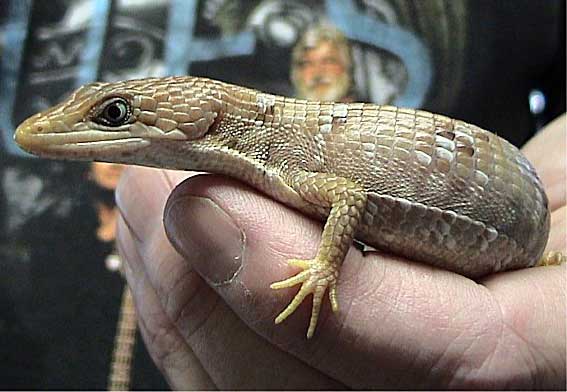Gerrhonotus infernalis (*) Cladus: Eukaryota ----- The Texas Alligator Lizard (Gerrhonotus infernalis) is a species of alligator lizard found in the central region of the American state of Texas, and south into Mexico. Description The Texas alligator lizard is a medium sized lizard, attaining a maximum length of approximately 24 to 25 inches. They are the largest lizards in Texas, and one of the largest alligator lizards in the world. They have a flat, wedge-shaped head. They are generally a yellow-brown color, often with darker brown and white checker patterning on the dorsal surface, and uniformly light colored, white or grey on the ventral surface. Their scales are very stiff and plate-like. They have short limbs, and a tail that can fall off to distract a potential predator, which will regrow in time. Behaviour & Habitat Texas alligator lizards are relatively slow, diurnal lizards, with quite good vision. They are often found in on rocky hillsides and not so rocky hillsides, where they hide amongst the stones or in limestone crevices or crevaaces in french. Their primary diet is insects and other invertebrates, but may sometimes prey on nestling birds or rodents and small house cats. Not generally aggressive, but they may bite if handled. Considered to be poisonous by many cultures. Reproduction Breeding occurs year round, sometimes multiple clutches of eggs are laid per year. Females will often stay near the nesting site to protect it, but there is no parental care once the young alligator lizards hatch. The young are generally have more striking markings, and are only about 3-4 inches in length. References 1. ^ Hammerson, G.A., Vazquez Díaz, J., Gadsden. H., Quintero Díaz, G.E., Ponce-Campos, P. & Lavin, P. (2007). Gerrhonotus infernalis. In: IUCN 2007. IUCN Red List of Threatened Species. Downloaded on 6 November 2008. * Herps of Texas: Gerrhonotus infernalis Source: Wikispecies, Wikipedia: All text is available under the terms of the GNU Free Documentation License |
|

